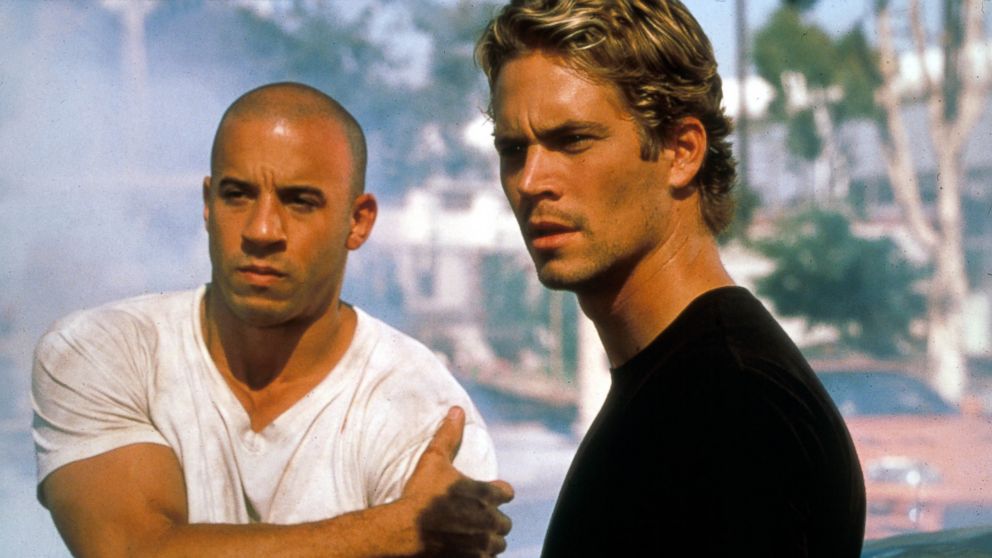Fast & Furious (2009)
What goes up must come down. Of course, defining the
comedown in the Fast and Furious franchise
is a matter of debate. The film series hit its financial low with the previous
film, Tokyo Drift, since audiences
apparently wouldn’t bother with a Fast film
that didn’t feature either Paul Walker or Vin Diesel in the lead role. This
didn’t matter on the creative front though; series newcomers Justin Lin
(director) and Chris Morgan (writer) were brought in to conceive an
in-name-only Fast movie that was
originally slated to go direct to video and in the process they created the
best one up to that point. Likely sensing a great opportunity for rejuvenation,
the producers kept Lin and Morgan for the next chapter and reunited the stars
of the original movie that started it all. The decisions worked out on their
end, as the starkly titled Fast &
Furious brought the series back into the pop culture forefront. The film
itself is another matter, however, as it settles into a dour tone that saps the
life and excitement out of the whole endeavor in a bid for integrity.
Things start out fine enough. The opening heist on a gas
tanker announces that we’re in back familiar territory with old friends Dom,
Letty, and…Han?! That’s right, the best character from the Tokyo diversion is alive and well, and his short appearance
positions this film as a prequel. Anyway, the thrilling heist goes awry but Dom
and Letty make it out alive after dodging the horrifying sight of bad special
effects. Our reconnection with these two is short-lived as they go their
separate ways and Dom learns some time later that she was murdered in
connection with drug lord Arturo Braga. Dom’s search for her killer reunites
him with Brian O’Connor, who has (inexplicably) joined the FBI and is also on
Braga’s trail, so the two join forces in revenge for their slain friend.
The death of a character who barely clocked more than half
an hour of screen time across two films doesn’t register as strongly as it does
for Dom, but it’s a satisfying enough setup for him to cross paths again with
Brian. Each of them also gets their own reintroduction action sequence too,
with Dom’s recalling the truck-jacking days of old in Los Angeles and Brian’s
set-piece signaling the next change of direction and tone for the series. Whereas
Lin took the neon-infused style of the first two films and jacked it up on
steroids for Tokyo Drift, the
director attempts to reignite the old L.A. spark by shaking off all the shallow
surface details that the series became defined by.
Harsh blues, grays, and browns now define this updated world
in place of the familiar colorful hues, but Lin struggles to maintain his sense
of fun in this new “realistic” take. The movie practically begs the audience to
take it seriously, and these characters may hold pathos between them but even
they can’t shoulder the dramatic weight placed on them here. Everything is so
grim that it’s difficult to find a smile in the humorless bro posturing. The
stylistic shakeup isn’t all for naught though. Brian’s first chase sets the
tone off on the right foot with such breathless pacing and choreography that
you half expect Jason Bourne to come barreling through the scene. And while Vin
Diesel doesn’t quite recapture the adventurous twinkle in Dom’s eye amidst the
po-faced grimness, Paul Walker feels more comfortable in his role than he ever
did before.
The movie also has a potentially worthwhile villain in Braga
thanks to actor Jon Ortiz. It’s a shame that Braga is so underutilized, and
with a twist as predictable as can be, since Ortiz later proved with Silver Linings Playbook that he’s a
reliable character actor who can steal scenes from bigger stars with ease. He’s
not in the picture long enough to truly make an impact but in a series that
often struggles with creating strong villains he’s better than most of them.
Our heroes also cross paths with series newcomer Giselle (played by Gal Gadot)
in their quest for revenge against Braga, but she’s given little to do as well and
her chemistry with Diesel is non-existent.
The movie occasionally springs back to life when it lets Lin
cut loose in his toy car sandbox, and the director cooks up a mid-film race way
more exciting than almost anything that Singleton and Cohen achieved in their Fast entries. But even the new series
shepherd can’t help but fall into his predecessors’ missteps that he so gracefully
dodged in his Tokyo outing. Lin mostly sticks to a do-it-all-for-real method of
action until collapsing into a lengthy sequence of nothing but dimly lit cars
driving through Playstation-level cave walls. His inconsistent work here
reveals a franchise that still, four films in, hasn’t 100% found its central
identity. Fast and Furious ends up
stumbling further than it ever did before with its attempts to rekindle an old fire,
and it doesn’t nearly prepare us for the dizzying heights that would follow.




















